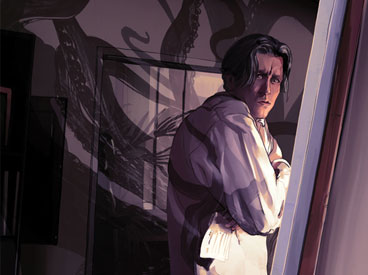
Larry Hogarth stood in his office at the back of the gallery, arms crossed, eyeing his latest acquisition with silent glee. The big canvas, unsigned, unframed, and a little tattered at the edges, dealt with religious themes. Hogarth saw at least three different biblical stories crammed in together, each situated in a different portion of the canvas, yet intertwining and overlapping. Here was Moses, calling down the frogs and flies upon Egypt, and Satan, thrust from heaven in a ball of flame, and Jacob, assailed on his ladder by a faceless long-bodied creature from hell. The painting was in oils, with extensive use of gold leaf, as if to remind the viewer of grim medieval times when such salutary art had been the norm. All that gold, allied to the preoccupation with punishment and cruelty, revealed the piece to be from the hand of J.V. Mortensen, from early in his career, Hogarth was almost sure, when Mortensen was living in Los Angeles, working out of a tin hut on Electric Avenue down in Venice. If Hogarth was right about this, and after all he’d put down actual money in the belief that he was right, this picture could easily be worth $25,000.
Twenty-five grand! thought Larry Hogarth, who was tall, and of uncertain middle-age, still handsome, in a decayed sort of way, but running to fat and with unkempt gray hair that came to his shoulders. His mean slot of a mouth encircled loose and creaky teeth. He had a baggy and slightly pockmarked face, glazed by a film of sweat, the face of a man who wants it all but never much likes what he gets, a man with something fundamentally untrustworthy in his grungy soul.
Twenty-five thousand dollars: however you looked at it, a tidy sum that would help keep the IRS at bay, enable a day or two in Vegas, seed the funding of a couple of new exhibitions, and some much needed dentistry. It could even pay off a little of the alimony his ex-wives clamored for. Those vultures! Maybe he’d forget about the alimony.
“Excuse me, Larry,” said Nora Vazquez, Hogarth’s assistant, standing in the doorway with her customary shy awkwardness. She was a skinny girl with incredible eyes and the tattoo of a rose on her shoulder. “Somebody to see you.”
“Who?”
“I don’t know. She didn’t say,” said Nora, compelled to add: “She’s, like, totally beautiful.”
“As beautiful as you, Nora?” said Hogarth with a twinkle, noting with satisfaction the blush that rose through Nora’s cheeks. Her withdrawn manner hinted at roiling sexual depths. Or so it seemed to Larry Hogarth, that devout opportunist. He was paying Nora’s salary after all. Well, not exactly. She was an intern on vacation from film school at USC. Nobody could deny he was doing her a favor.
“I’ll be right out,” Hogarth said, casting a final glance at the Mortensen canvas, struck by the hellish figure that was tormenting Jacob in the center of the picture. Not a dog, Hogarth concluded, nor yet a leopard or any other kind of dangerous cat. There was something uncertain and vague about the creature, almost as if Mortensen himself, usually such a meticulous impresario of his worlds, had been so haunted by this particular creation that he could not bring himself to finish it.
The woman was slender, with ash-blond hair falling straight and satin-sheeny long. She wore a white silk blouse and tight jeans with just the right amount of expensive fade. Silver rings adorned vermilion-painted toes that peeped out from within soft leather sandals. An actress, Hogarth knew. Megan Something. An Irish name. She’d been big, about 10 years ago, and carried herself as though she still was, with a certain impetuous and airy confidence. Had she landed a part in some new show he hadn’t heard about? Hogarth reminded himself to pay better attention to the trades. Megan Maloney. That was the name. How old was she? About 40, Hogarth reckoned, though she could easily pass for 35. And still exuding that certain sexual something, he had to admit. Her mouth was red as a strawberry.
“Hello! Hello! Hello!” said Hogarth, stepping up and offering his hand, never one to hide the angle of his profession that touched upon the sideshow barker. “How may I be of assistance?”
Megan Maloney’s cool, slender fingers touched Hogarth’s for only a second. She cocked her head to one side with a smile. “This is gonna sound, like, totally weird,” she began, talking like a ditzy teenager. “I’m here for a friend. She doesn’t know I’m here. But I’m, like, here. Because she lost a picture. More like some kind of a painting, I guess. About this big.”
Megan Maloney’s sweetly lotioned hands wafted around, sketching out a largish portion of air.
“Really?” said Hogarth. “What happened?”
“A while back my friend’s husband died in a car crash. He was still young, only in his 40s.”
“That’s sad,” Hogarth said, laying it on thick. Where was the harm?
“It was, like, totally tragic,” said Megan Maloney, shaking her head. “But my friend Lily, she’s been fighting to get past it. Anyway, she decided she needed to clean house a little. So her kids organized a garage sale. And this painting somehow got sold that shouldn’t have been.”
She smiled with a flourish, as if everything had now been explained, and, indeed, Hogarth saw the conversational road ahead.
“It’s by J.V. Mortensen,” Megan Maloney said.
Ah, thought Hogarth.
“I don’t know anything about art, not even what I like,” said Megan Maloney, throwing her amused eyes around at the pictures on the walls of the Hogarth gallery. “But I guess he’s pretty famous.”
“For sure,” agreed Hogarth equably, sucking at a sore spot on his upper left gum. Damn teeth. An insistent reminder of mortality. “Mortensen has a following.”
“He and Lily’s husband were friends. The painting was a gift. Lily’s, like, ashamed because she never really liked it.”
“Why?”
“She says something about it scared her,” said Megan Maloney, raising and dropping her shoulders with a shrug of practiced elegance. “How weird is that?”
“Art can perturb. It should be part of the territory,” said Hogarth.
“No kidding! That painting feels important to Lily now, though.”
I bet, thought Hogarth, picturing the grief-filled widow, greedy for bucks. “I feel for your friend, but I can’t remember when I last saw a Mortensen,” he said. “I’ll ask around. Do you have a photograph of the picture?”
“Well, like, duh – no!”
“A pity,” said Hogarth, stuffing his voice with concern. “That would have been helpful.”
Megan Maloney crossed her arms. She puffed out her cheeks. She was looking at Hogarth interrogatively. “You’re not making this easy, are you?”
“I’m not sure I catch your drift,” he said.
“Let’s face it, dude. You gave a 10-year-old kid five bucks for that picture.”
Hogarth felt his hair prickle and his spine stiffen.
“You stole it.”
All his life people had been telling Larry Hogarth he was wrong, or selfish, or bad, and he did hate to be so accused. He refused to contemplate standing down, or confessing, or even feeling ashamed.
“I think you should leave now,” Hogarth said, bringing his dodgy teeth together with a click. What could this sexy clown of a woman do with her painted little toes?
“Listen, sleazoid, you are so busted,” said Megan Maloney, no longer ditzy, more like a lioness with a toothache. “Hand over that picture — or live to regret it.”
“Threats?” Hogarth made no effort to disguise his amusement. “Get the hell out of my gallery and go get your career back, bitch.”
Megan Maloney raised her eyes to his.
And then time passed. Time must have passed. It had to have. But Hogarth could remember none of it. One moment he was standing on the polished gray stone floor of his gallery with Megan Maloney. The next moment, or it seemed like it was the next moment, his feet remained in the exact same position, but she was gone, and instead he faced the gallery’s shut door and the windows of plate glass that looked out onto the bustle of 16th Street.
Nora Vazquez was where she’d been, behind her little desk in the corner. But was the screen of her iMac glowing brighter, bluer? Had the light in the gallery therefore grown dimmer? Hogarth felt faint and dizzy, as though the physical bits of his brain, the very cells and bones and blood vessels themselves, were shifting and spinning like a broken crystal ball or the inside of a kaleidoscope.
“Are you alright? Do you need a little drinkie?” a voice was saying, the voice of a woman he’d never seen before and hadn’t noticed come in. She called across to Nora Vazquez. “Bring this poor man a glass of water. Or a shot of vodka.”
Become a Saturday Evening Post member and enjoy unlimited access. Subscribe now



